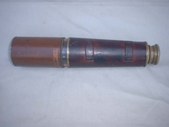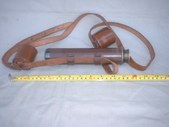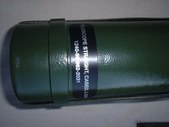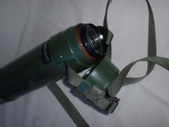Note: After you click on images to ENLARGE them, you may find they automatically size smaller in your browser's window making them hard to read. The auto sizing is your browser's way of keeping images entirely within the screen size you have set. If this happens, you will see a small box in the bottom right hand corner of the pic with four arrows point outwards. Click this box and the pic will EXPAND and open up to its normal size, so you should now be able to read any text and make out small details.
Spotting/Observers Telescopes
By Peter Laidler
There were two common telescopes in the No4T chest, the specified TELESCOPE, Scout, regiment and another called the TELESCOPE, Signaling (or is it signalers?) or just commonly among the Armourers, the GS (for general service). There were another couple that did find their way into the kit and they were the Telescope, Admiralty Pattern and another, the little Telescope, GP (for general purposes). The Admiralty pattern looked to me like it was simply a GS telescope made for the Admiralty! I’m going to call this the Tele GP/Adm patt. Whereas the little GP telescopes looked to me as though they were truthfully really small commercial telescopes, x20 magnification, snapped up from the trade during the war and manufactured by Broadhurst and Clarkson although there were probably others from the Dolland, TTH and N&Z stable too.
These little uncommon GP’s deserve a little more explanation. They were, if my memory is reasonably correct, about 9” long and some 2” in diameter or so and were the usual 3 drawer configuration. Some carried the commercial trademarks and if my memory serves me right, one that I ‘liberated’ and later swopped for something probably worth peanuts carried the trade name ‘TITANIC’. Probably worth a mint now ….., such is the folly of youth. But interestingly, many of these including the little ‘Titanic’ model I had, carried RAF issue markings with the letters AM aside a small crown or an arrow and the usual 6E-XXX type RAF stores number. This could prompt the question as to whether these telescopes were supplied with RAF issued sniper rifle kits. After all, until the late 60’s, the Air Ministry were responsible for their own small arms supplies until standardization took over in the 70’s. I do recall that the binoculars within the RAF issue sniper rifle kits came without the usual military reticle pattern. Even in the mid to late 60’s, RAF equipment and small arms brought into REME 40 Base Workshops, came in on different paperwork because, as it was explained to me by Mr Lim the progress chaser, the Air Ministry were actually billed for the service…..! No…, I don’t believe that money was passed between the War Office and the Air Ministry either!
The problem with the Scout regiment, GP/Admiralty pattern was that they were manufactured by many different manufacturers and probably to the same drawing! But there, any similarity ends. As for component parts being interchangeable, well, they weren’t. The problem was that when spare parts were ordered after the war, they all came beautifully Ordnance wrapped, - straight from Broadhurst & Clarkson! I never saw a new replacement spare part for a Tele GP/Adm patt. All we had at out Field and Base workshops came from cannibalized telescopes that Sgt Dennis Aslett kept in a felt lined box. But it wasn’t all bad news. Because of the construction, many parts COULD be adapted from the Scout Reg scope spare parts. For example. The Object glass was, if my memory serves me right, much larger than that of the Scout telescope so instructions were issued (or if they weren’t, then it soon became common knowledge among and passed down to Base Workshop instrument technicians) that if you internally machine and thread the actual Tele GP/Adm patt object lens housing (called the counter cell) internally, you could simply insert into it the complete object lens assembly into the machined housing. Secure it with soft solder if need be and hey presto, there you have a ‘new’ object lens from a Scout tele for your GP tele. The same applied to the ocular lens eye-piece and lens….. and best of all, the erector too Providing the threads mated up. They usually did but if not, the instructions stated that ‘ …it may be necessary to thread chase the male thread accordingly’. There will be various ways of doing this but I found that the easiest way to chase the threads was to take it to the fitters section and ask the fitter/turners to do it! At least they’d do it properly whereas when I did it, it was usually with a saw blade, ground to 55 degrees and chased by hand! It usually worked……, after a fashion. This mix and match of parts did affect the focal length and infinity focusing of the telescope a little but as there was no grat to worry about it remained x20 or so magnification and was clear, it was of no consequence and out they went, as good as new.
By remarkable coincidence, even this GS telescope, borrowed just to photograph for the article had been repaired by using a what looks to be shorter Scout Regiment telescope front shade!

(Click PIC to Enlarge)
This is another of those telescopes to be found inside the sniper chest. This time another from the Broadhurst and Clarkson stable. Still x20 magnification but a slightly reduced field of view. These were often encountered with ex RAF regiment No4T sniper kits. Although this one isn’t marked and was probably always a commercial telescope, the ex RAF ones usually have the A-arrow-M (Air Ministry) mark plus their 9Exxxx stores identification mark.

(Click PIC to Enlarge)
(Click PIC to Enlarge)
This is another of those telescopes to be found inside the sniper chest. This time another from the Broadhurst and Clarkson stable. Still x20 magnification but a slightly reduced field of view. These were often encountered with ex RAF regiment No4T sniper kits. Although this one isn’t marked and was probably always a commercial telescope, the ex RAF ones usually have the A-arrow-M (Air Ministry) mark plus their 9Exxxx stores identification mark.
(Click PIC to Enlarge)
Perhaps someone could strip down a Scout Regiment and Telescope, Signalers and GS together to see just what parts do/will interchange. But before you start, make sure that you mark them!
That having been said, by the time I returned to the UK and certainly by the time the L42 had come fully into the system, by about 1978/79 or so then the Scout Reg tele was the norm and had.................
That having been said, by the time I returned to the UK and certainly by the time the L42 had come fully into the system, by about 1978/79 or so then the Scout Reg tele was the norm and had been re-named the ‘TELESCOPE, STRAIGHT, L1A1’ and the whole caboodle, including the case had changed to ‘TELESCOPE, Straight, cased, L1A1’, V5-1240-99-962-2031. Don’t get me started on the vagaries of the L1A1 type suffixes……. And NO, this isn’t the Telescope, Straight, SIGHTING, L1A1 either……, that was something different! They were enough to turn even the most knowledgeable storeman to drink! I ASSUMED that by ’78 or ‘79 the Scout Regiment was the norm until I looked into a No4T chest at work and found, tucked into the box ….., you’ve guessed it, a GS Signaling! You have probably asked why it was a TELESCOPE, Scout, Regiment. It’s not that there was ever a Scout Regiment like, say, the Essex Regiment. It was a telescope to be used by the regimental scouts. These were the regimental signalers who previously used ………, yes, you’ve got it, the telescope, signalers. Well, I presume so! There was also a ‘STAND, heliograph’ that went with the scout scope too. A magnificent wooden beast, full of bits and pieces, thingummies and wotsits and thingies for holding the wotsit tight. I saw one of these in a school CCF range for a couple of years, complete with the alloy ‘STAND, Heliograph’ makers tag, made by the pre-war version of REMPLOY. And talking of which, so did the GP scope have a stand too but I haven’t seen one. No doubt the Admiralty pattern had a stand too, made from brass, copper and gunmetal with gleaming this that and the other……………………………….
What were the problems with them. The truth and short answer is, there weren’t that many, with any of them! Stripped threads were a bit of a problem on the Scout Reg scope but this was usually by way of a poor fit of a replacement component rather than the actual thread being torn away. It could be cured by selectively fitting a ‘good fit’ part but otherwise, on a packing gland, then a run of solder down the threads at 90, 180, 270 and 0 degrees and left to cool would usually allow a gland to be tightened by recutting its own thread. We did have a small pipe-cutter type tool with rounded rollers that would roll and compress on the outside of the thread but I never used it! The main problem was cross threading the fine field lens threads. You’d think that when the crossing thread did eventually tighten up, as it always will, that it’d be time to stop screwing and take stock. But NO. This meant a bit of deft filing with a triangular needle file but we always solved the problem. Packing glands, yes……
The ‘packing gland’ is an everyday common term for what was officially called in REME technical language, the ‘STOP, Drawer, extending’. There were 3 of these ‘STOPS, drawer’ on the telescope. Each ‘stopped’ a tube, called a ‘DRAWER’, being the DRAWER, 1st (smallest) or second (middle) or third (larger) with the main outer one being called ‘CASING, main’. These drawers weren’t available as spare parts due to their being a matched and mated set. If we ever needed one to make up an otherwise serviceable scope, a phone call to the Inspection Branch at the Returned Stores Sub Depot would usually see one arrive on the next stores truck. I don’t ever recall seeing an illustrated parts list for the telescopes either but I’d like to see one if anyone has one. The V5 optical stores VOCAB (short for Vocabulary of Army Ordnance Stores or VAOS or Various Army Odds and Sods) list wasn’t illustrated but you just knew what was what and the peculiar ways of the Ordnance stores system after a couple of years.
The inspection standards for these telescopes states that the telescope shouldn’t extend under its own weight. My boss used to say that that means holding the ocular/eye lens end and allowing it to extend under the weight of the heavy front end ….., and not the other way round! On the other hand, when it came to my time in the chair of King Solomon, I reversed it and accepted it as ‘serviceable’ if it didn’t open under its own weight by holding the OG end. If it did extend under its own weight, it meant that the packing gland material needed replacing. The material we used was ‘FELT, hatters, green’ and it came on a xxxxing great green roll, about 50 yards long and doubled up widthwise to about a yard across! Are we still allowed to use yards …., if not, feel free to correct me and I’ll revert to centi-inches! And if you imagine that we probably overhauled 100 or so telescopes a year, each one had 4 packing glands, each requiring a piece of felt just over 1” or so wide by, say 2” or so long, then that’s not a lot of felt to be used ….., but there you go! We’d dip the old glands into a tank of boiling trichloroethylene vapour to dissolve the old packing together with our nasal pathways, chests and lungs while it did so. Then we’d fit the new hatters felt into the internal recess with a chisel shaped piece of hard wood and pack it with silicon grease until the gland slid tightly but freely and without interruption down the tube ‘…….like a well worn sea-boot’ as my old boss, Sgt Tony Bowman used to say. But to be fair, in this context, I think he was talking about his girlfriend Brenda ………., but I digress We didn’t glue the felt in place as I recall but as it’s in its own sealed self contained gland and it ain’t going no-where, there was no need I suppose. Where do you get some hatters felt, well, any haberdashers would stock it presumably.
As for the leather coverings, well we didn’t worry about it too much. If it was tatty and torn then it’d be ripped off and replaced with a black non stretch material called REXINE that would be cut to shape and glued on. There was always a brass cutter template handy for this job, marked as to what telescope it was for and we’d regularly do the same with the covering of No2 binoculars too. Oh yes, and like the hatters felt, the rexine only came in wasteful rolls of about 25 yards ……. and you can only ask the equipment repairer to re-cover the seats of your old clapped out Triumph so often! The brown ‘wood-chip’ finish of the HCR telescopes was subject to the same treatment. In the trike tank and recovered with rexine. I did see some telescopes where the draw tubes had been through the Armourers bead blasting and phosphating tank and emerge black painted too. This wasn’t ever officially approved but you know what its like………. So if you do see or have one with black painted draw tubes, that’s the reason.
LENSES
Mmmmmmmm. Cracked and broken OG lenses were the main problem but these were available aplenty as ‘LENS, Assembly Objective’ complete with the brass counter cell housing. That was until the last batches came through in the very early 80’s or so then it was just the actual glass lens and then as the spares slowly dried up the telescopes were declared obsolescent, then obsolete shortly afterwards. Originally, OG lenses were a set of the usual flint and crown. But later, a cemented doublet. Now, here’s a little tip for you. One of the doublets consists of a very slight convex (outwards) curve and a concave (inwards dish) while the other is a double convex (outwards curves). But each convex isn’t exactly the same. So which convex do you mate with the concave? I’ll tell you. Clean both sides of each with methylated spirit until perfectly clean and grease free then put a bit of spit into the dish of the concave lens. Now put one side of the double convex lens into the dish and note how far it spreads out the blob of spit. Now do the other. The radiused side that spreads the spit the furthest is the matching side. Mark the outside of each lens with a pencil mark (I used to pencil an arrow, pointing inwards on each) so that in future, arrows pointing to each other, they’d always be matched. Assembly into the counter cell is radius first and the flattest surface should then face into the erector and field lens. Lock up with the counter cell locking ring. And it’s as simple as that! I almost forgot to mention it but the MAIN reason the OG lenses broke was because it wasn’t protected at all. In fact, the counter cell actually protruded slightly out of the front of the ‘protective’ front ray shade and the first thing to hit the ground as it rolled was, you’ve guessed it, the OG counter cell and the hard and brittle flint glass lens that proceeded to break! The remainder of the lenses were well protected within the bowels of the tube and rarely gave any trouble
Lenses don’t need to be cleaned with anything more than a flick over with a soft camera lens brush and wiped with a clean paper kitchen towel dipped in meths.
Recently I found a short report from 1942 or so to the effect that the Telescope Scout Regiment was only selected for the No4T chest as an afterthought, due to the fact that it was the only telescope a) that was available in reasonable numbers, b) currently in production and c) that fitted into a convenient space in the chest!
THE CASES
The standard Scout Regiment scope originally came with its leather carrying case, made incidentally by ladies working freelance from home who were supplied the pre-cut leather. And didn’t they do a superb job too!
After the introduction of the ‘new’ plastic case, the designation of the ‘old’ leather case changed to CASE, Telescope, scout regiment. It eventually got very complicated……

(Click PIC to Enlarge)
(Click PIC to Enlarge)
In 1980 or so, instructions were issued that the case should be marked with the new designation of ‘TELESCOPE, straight cased’. So if yours has this stamped into the side, then it’s from an L42 era telescope. When these started to become worn out and beyond repair by the equipment repairers, a kakhi/green moulded plastic case became available and these were designated as ‘CASE, sighting telescope ‘tropical climate’. Not as tough and robust as the leather original version, the bottom edges cracked but did the job. The other telescopes, such as the little RAF GP’s and the Tel GP/Adm Patt. had simple end caps, retained by the carrying strap. But I don’t think I ever saw more than a few complete with the caps. So while they were fitted into the rifle chests, I don’t know how the snipers ever kept them clean unless it was wrapped in an old sock or shirt tail! I have learned since those days that the signalers telescope originally had a small secondary case, that housed a large magnifying ocular sub unit ….., to 40x magnification! No I never saw one either and it’s not in my experience something that a sniper or his observer would use, even in the purely observation role!
The markings on the plastic case. This number, 1240-99-962-2031 identifies the complete telescope and case as an assembly.

(Click PIC to Enlarge)
The Scout Regiment telescope tucked into the case. This number (barely visible, but 1240-99-966-0837) is that of the actual case only.

(Click PIC to Enlarge)
(Click PIC to Enlarge)
The Scout Regiment telescope tucked into the case. This number (barely visible, but 1240-99-966-0837) is that of the actual case only.
(Click PIC to Enlarge)
As for the later militarized ‘SWIFT’ telescopes, well there’s no doubt that they were beautifully made, perfect optics and a pleasure to use but dear, oh dear! Once sand, grit or anything else likely to penetrate into and foul the multi-start silicon greased threads then there’s trouble ahead…….., and there was! The trouble with it was that it wasn’t a) moisture proof and b) as events unfolded, sand and dust proof either! If you needed a telescope, perfect. But if you were a SNIPER and needed a telescope….. Unlike the Scout and GP where stripping and cleaning was what we call a ‘user task’. It’s all down to the ease at which alloy threads bind. There WAS an answer and that was to FIX the focus at infinity AND the magnification to x20 with small grub screws down at the ocular end.
As of to date, the Telescope Scout Regiment is still, just in the twilight of its long service and occasionally ….., just occasionally, you’ll still see a Telescope Signaling and GS. But I bet you this…., that the Navy still have a few of the similar Telescope Admiralty Pattern in stock!
Copyright ©2006 - 2009 by Peter Laidler and MILSURPS.COM
Collector's Comments and Feedback:
1. Capt. Peter Laidler is the senior Armourer in the UK Military, now retired, but based as a Technical Officer at the UK Military Small Arms School. In addition to being a trained and highly experienced military "Armourer", he has authored two excellent books about the No.4(T) sniper rifles and their No.32 scopes. They are titled "An Armourer's Perspective: .303 No.4(T) Sniper Rifle", which he co-authored with Ian Skennerton and his own dedicated work, "Telescope Sighting No.32".
If you're really interested in some in-depth learning about the No.4(T) sniper rifles and the No.32 series of scopes, their history, evolution, repair and adjustments for shooting, I'd highly recommend those two books, which are pictured below. ....... (Feedback by "Badger")
Note: The opinions expressed herein or statements made in this article are solely those of the author, and do not necessarily reflect the views of the Military Surplus Collectors Forums, or the ownership and moderation group of this site. MILSURPS.COM accepts no legal liability or responsibility for any claims made or opinions expressed herein. Also, please note that neither the author nor MILSURPS.COM recommends that any member of these forums, or a reader of this article, try this type of experimentation without the proper knowledge, equipment and training.









 Countries
Countries Categories
Categories Recent Article Comments
Recent Article Comments

